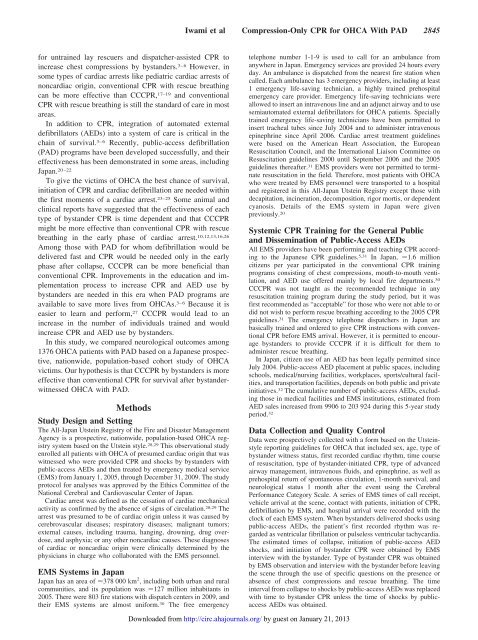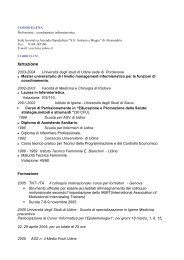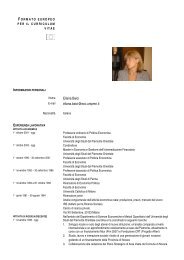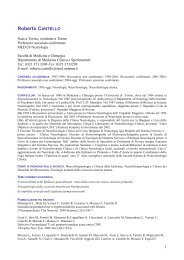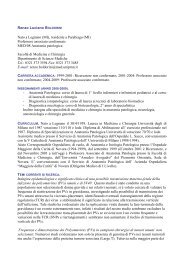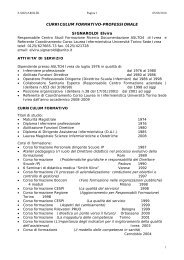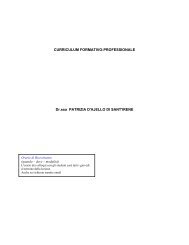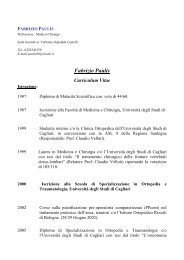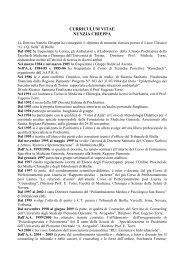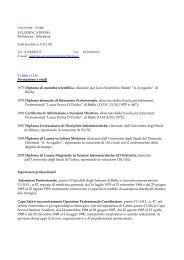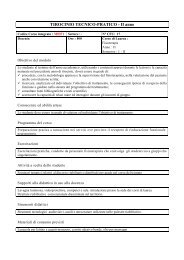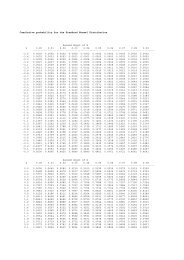for the Japanese Circulation Society Resuscitation Science Study ...
for the Japanese Circulation Society Resuscitation Science Study ...
for the Japanese Circulation Society Resuscitation Science Study ...
Create successful ePaper yourself
Turn your PDF publications into a flip-book with our unique Google optimized e-Paper software.
Iwami et al Compression-Only CPR <strong>for</strong> OHCA With PAD 2845<strong>for</strong> untrained lay rescuers and dispatcher-assisted CPR toincrease chest compressions by bystanders. 3–6 However, insome types of cardiac arrests like pediatric cardiac arrests ofnoncardiac origin, conventional CPR with rescue breathingcan be more effective than CCCPR, 17–19 and conventionalCPR with rescue breathing is still <strong>the</strong> standard of care in mostareas.In addition to CPR, integration of automated externaldefibrillators (AEDs) into a system of care is critical in <strong>the</strong>chain of survival. 3–6 Recently, public-access defibrillation(PAD) programs have been developed successfully, and <strong>the</strong>ireffectiveness has been demonstrated in some areas, includingJapan. 20–22To give <strong>the</strong> victims of OHCA <strong>the</strong> best chance of survival,initiation of CPR and cardiac defibrillation are needed within<strong>the</strong> first moments of a cardiac arrest. 23–25 Some animal andclinical reports have suggested that <strong>the</strong> effectiveness of eachtype of bystander CPR is time dependent and that CCCPRmight be more effective than conventional CPR with rescuebreathing in <strong>the</strong> early phase of cardiac arrest. 10,12,13,16,26Among those with PAD <strong>for</strong> whom defibrillation would bedelivered fast and CPR would be needed only in <strong>the</strong> earlyphase after collapse, CCCPR can be more beneficial thanconventional CPR. Improvements in <strong>the</strong> education and implementationprocess to increase CPR and AED use bybystanders are needed in this era when PAD programs areavailable to save more lives from OHCAs. 3–6 Because it iseasier to learn and per<strong>for</strong>m, 27 CCCPR would lead to anincrease in <strong>the</strong> number of individuals trained and wouldincrease CPR and AED use by bystanders.In this study, we compared neurological outcomes among1376 OHCA patients with PAD based on a <strong>Japanese</strong> prospective,nationwide, population-based cohort study of OHCAvictims. Our hypo<strong>the</strong>sis is that CCCPR by bystanders is moreeffective than conventional CPR <strong>for</strong> survival after bystanderwitnessedOHCA with PAD.Methods<strong>Study</strong> Design and SettingThe All-Japan Utstein Registry of <strong>the</strong> Fire and Disaster ManagementAgency is a prospective, nationwide, population-based OHCA registrysystem based on <strong>the</strong> Utstein style. 28,29 This observational studyenrolled all patients with OHCA of presumed cardiac origin that waswitnessed who were provided CPR and shocks by bystanders withpublic-access AEDs and <strong>the</strong>n treated by emergency medical service(EMS) from January 1, 2005, through December 31, 2009. The studyprotocol <strong>for</strong> analyses was approved by <strong>the</strong> Ethics Committee of <strong>the</strong>National Cerebral and Cardiovascular Center of Japan.Cardiac arrest was defined as <strong>the</strong> cessation of cardiac mechanicalactivity as confirmed by <strong>the</strong> absence of signs of circulation. 28,29 Thearrest was presumed to be of cardiac origin unless it was caused bycerebrovascular diseases; respiratory diseases; malignant tumors;external causes, including trauma, hanging, drowning, drug overdose,and asphyxia; or any o<strong>the</strong>r noncardiac causes. These diagnosesof cardiac or noncardiac origin were clinically determined by <strong>the</strong>physicians in charge who collaborated with <strong>the</strong> EMS personnel.EMS Systems in JapanJapan has an area of 378 000 km 2 , including both urban and ruralcommunities, and its population was 127 million inhabitants in2005. There were 803 fire stations with dispatch centers in 2009, and<strong>the</strong>ir EMS systems are almost uni<strong>for</strong>m. 30 The free emergencytelephone number 1-1-9 is used to call <strong>for</strong> an ambulance fromanywhere in Japan. Emergency services are provided 24 hours everyday. An ambulance is dispatched from <strong>the</strong> nearest fire station whencalled. Each ambulance has 3 emergency providers, including at least1 emergency life-saving technician, a highly trained prehospitalemergency care provider. Emergency life-saving technicians wereallowed to insert an intravenous line and an adjunct airway and to usesemiautomated external defibrillators <strong>for</strong> OHCA patients. Speciallytrained emergency life-saving technicians have been permitted toinsert tracheal tubes since July 2004 and to administer intravenousepinephrine since April 2006. Cardiac arrest treatment guidelineswere based on <strong>the</strong> American Heart Association, <strong>the</strong> European<strong>Resuscitation</strong> Council, and <strong>the</strong> International Liaison Committee on<strong>Resuscitation</strong> guidelines 2000 until September 2006 and <strong>the</strong> 2005guidelines <strong>the</strong>reafter. 31 EMS providers were not permitted to terminateresuscitation in <strong>the</strong> field. There<strong>for</strong>e, most patients with OHCAwho were treated by EMS personnel were transported to a hospitaland registered in this All-Japan Utstein Registry except those withdecapitation, incineration, decomposition, rigor mortis, or dependentcyanosis. Details of <strong>the</strong> EMS system in Japan were givenpreviously. 20Systemic CPR Training <strong>for</strong> <strong>the</strong> General Publicand Dissemination of Public-Access AEDsAll EMS providers have been per<strong>for</strong>ming and teaching CPR accordingto <strong>the</strong> <strong>Japanese</strong> CPR guidelines. 5,31 In Japan, 1.6 millioncitizens per year participated in <strong>the</strong> conventional CPR trainingprograms consisting of chest compressions, mouth-to-mouth ventilation,and AED use offered mainly by local fire departments. 30CCCPR was not taught as <strong>the</strong> recommended technique in anyresuscitation training program during <strong>the</strong> study period, but it wasfirst recommended as “acceptable” <strong>for</strong> those who were not able to ordid not wish to per<strong>for</strong>m rescue breathing according to <strong>the</strong> 2005 CPRguidelines. 31 The emergency telephone dispatchers in Japan arebasically trained and ordered to give CPR instructions with conventionalCPR be<strong>for</strong>e EMS arrival. However, it is permitted to encouragebystanders to provide CCCPR if it is difficult <strong>for</strong> <strong>the</strong>m toadminister rescue breathing.In Japan, citizen use of an AED has been legally permitted sinceJuly 2004. Public-access AED placement at public spaces, includingschools, medical/nursing facilities, workplaces, sports/cultural facilities,and transportation facilities, depends on both public and privateinitiatives. 32 The cumulative number of public-access AEDs, excludingthose in medical facilities and EMS institutions, estimated fromAED sales increased from 9906 to 203 924 during this 5-year studyperiod. 32Data Collection and Quality ControlData were prospectively collected with a <strong>for</strong>m based on <strong>the</strong> Utsteinstylereporting guidelines <strong>for</strong> OHCA that included sex, age, type ofbystander witness status, first recorded cardiac rhythm, time courseof resuscitation, type of bystander-initiated CPR, type of advancedairway management, intravenous fluids, and epinephrine, as well asprehospital return of spontaneous circulation, 1-month survival, andneurological status 1 month after <strong>the</strong> event using <strong>the</strong> CerebralPer<strong>for</strong>mance Category Scale. A series of EMS times of call receipt,vehicle arrival at <strong>the</strong> scene, contact with patients, initiation of CPR,defibrillation by EMS, and hospital arrival were recorded with <strong>the</strong>clock of each EMS system. When bystanders delivered shocks usingpublic-access AEDs, <strong>the</strong> patient’s first recorded rhythm was regardedas ventricular fibrillation or pulseless ventricular tachycardia.The estimated times of collapse, initiation of public-access AEDshocks, and initiation of bystander CPR were obtained by EMSinterview with <strong>the</strong> bystander. Type of bystander CPR was obtainedby EMS observation and interview with <strong>the</strong> bystander be<strong>for</strong>e leaving<strong>the</strong> scene through <strong>the</strong> use of specific questions on <strong>the</strong> presence orabsence of chest compressions and rescue breathing. The timeinterval from collapse to shocks by public-access AEDs was replacedwith time to bystander CPR unless <strong>the</strong> time of shocks by publicaccessAEDs was obtained.Downloaded from http://circ.ahajournals.org/ by guest on January 21, 2013


